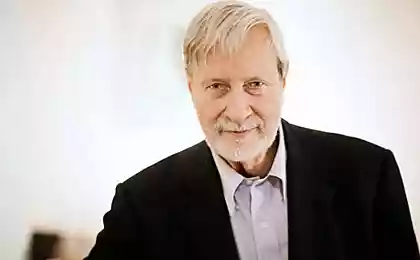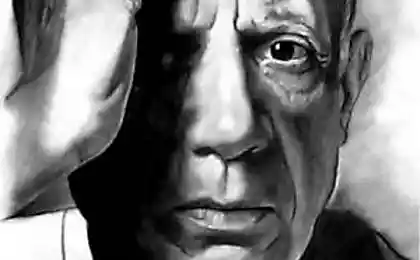218
Inventor Pablo Garcia on the prospects of fine art

The first about the camera-lucid - an optical device that allows you to accurately transfer the image on paper - spoke the great astronomer Johannes Kepler. 400 years later, the American professor Pablo Garcia developed a model available not only to collectors of antiques, and did not hesitate to bring it to Moscow. T&P asked the inventor about his NeoLucida, robot artists and the prospects of virtual reality.
- You insist that the history of new media should begin with antiquity. Tell me more about that.
- In the eighties, me and my peers were still teenagers, and we were surrounded by dreams of virtual reality: helmets, technology, like in “Star Trek”, and other projects from science fiction novels. I grew up with these ideas, but nothing has come true yet. And then I came to the idea that the phrase "virtual reality" is just a way of talking about special technology, and the concept of "virtuality" itself implies something more. I want to say that both the method by which artists from ancient times transferred real life to a flat image, and your shadow moving down the street, also belong to the category of “virtual”.
- In your work, you often turn to masters of the past – from Dürer to Muybridge – and give their works new life with the latest technologies. Why is this so important to you?
- I have always wondered how new technologies would have worked in the past: what would have happened if Albrecht Dürer had a computer? Just imagine how this genius would dispose of a tool that could simplify his work so much, and what his paintings would be if he hadn’t spent so much time calculating and drawing.
- You use a lot of old tools, from stereograms to your famous NeoLucida. How did you learn about them and when did you decide to use them?
- Some popular technologies accompany our lives: in my childhood, comics with 3D reading glasses were in vogue. I have always loved such things and have sought to find their more ancient, half-forgotten counterparts. The Internet has made this process easier: you can find someone who is experimenting with these technologies, question them, and build your own machine. In other words, it is no longer necessary to study serious historical literature to be an inventor. Inventions, by the way, have always interested me more than pure science: I never found much meaning in reading special books unless I could put that knowledge into practice.
- What does it mean for modern artists to study old technologies?
- As a professor at the Art Institute of Chicago, it was important for me to change the way my students think about good drawing and to show how the tools we use affect what we create. They were born in the late 1980s, and from the very beginning they were dealing with computers: I wanted to help them realize how much the old art tools had influenced the modern. I'm not a traditionalist, but I think it's necessary to internalize this continuity: after all, the desire to draw - on a computer or with your hands - has always been dictated by the same impulses.
Copying Dürer, the machine is like drawing a portrait of his great-grandfather.
- How widely do you think these technologies have been used in the past? In Tim's Vermeer, an experimenter who tries to copy Vermeer's paintings discovers that the artist was superbly equipped with technology, such as seeing light that can only be captured by a camera.
- This film was made at the same time that we were working on our Lucida, and we discussed the connections between our projects many times. Based on personal experience, I have no doubt that the old masters used a variety of devices and technologies. Upon learning of this, many accuse artists of fraud, forgetting how difficult such devices were to operate. If one of the artists had the technology that allowed him to draw more accurately and better, he received more orders, thereby developing his business. So I wouldn’t call it a fraud: if critics try to put these tools into practice, they will immediately feel the level of artistry of the past.
- So, did the masters know technology better than we do now? Today, technology is taught separately and art is taught separately – and in the past, artists were also inventors.
- This is a very good question – we have examples of Leonardo and Galileo before us, but most artists still worked with ready-made instruments. So when you go to the Hermitage, you see so many works that look alike, because they've been experimenting with the same technologies. And today we have a laptop, a camera, a keyboard. There are a huge number of people and communities who build their own appliances, so technology has become much more affordable than, for example, in the 1600s, when buying a lens was very difficult.
- Do you think computers can recognize the boundaries of objects? Or do you need to remember what these objects are?
- Computers aren’t my field of expertise, but I’m seeing more and more great technologies in the field. There are machines that can independently control the direction of movement, read street signs, recognize faces and all that. But computers don’t understand what they’re seeing; they’re just programmed to recognize patterns like Facebook. Facebook is able to mark faces in a photo: it looks for patterns of eyes, face and nose, but it can easily mistake the folds on your skirt for face if the light falls so that the patterns become similar. This technology can be very useful for beginner artists: you forget what you’re looking at, and you start acting in a world of shapes, colors and lines. This is how the computer and the camera in the phone see the world: they note where the dark area is located and where the light area is located, and place them in the correct order. So in a way, NeoLucida sort of shows things from a computer point of view — and makes the drawing process much more comfortable.
- And is it possible to reverse the process of transferring not reality to paper, but the image to the real world?
- Yes, and there are excellent examples of this – by the way, in the same “Vermeer of Tim”. Renaissance artists painted perspectives based on strict rules that - why not? - can be reconstructed by modern engineers.
- Let’s discuss your other projects, such as the machine that copied Dürer’s paintings. Have you tried to get her to create her own work?
- There are so many drawing machines that do something similar. We joked about a small round robot vacuum cleaner that rolls around the room: if you add a pen or brush to it, it will draw. The question I was interested in on this project was a little different: Can you teach a machine to draw its own past? Copying Dürer, it’s like painting a portrait of her great-grandfather, it’s part of her story that she’s just learning. But while machines are very limited in their perception of the image: distinguishing between tone and brightness, they often draw lines and shapes.
- One of the roboticists I interviewed said he didn’t understand why people expected machines to solve creative problems. What do you think?
- Art is always asked about the surrounding culture, science and life. Impressionists appeared with the development of photography, ensuring that this technology was not under force. The context of our time is computerization, and artists cannot help but touch on this in their work. I don’t think they want to shift their work to a computer; they’re more curious about what he can do—as a father is curious about what his child is capable of. It is a test of its capabilities and limits. Along the way, we find out what it means to be human, trying to understand what is so special about us. But the main reason is simple: we use the technology because it is available. Artists are the first to break the rules and misuse things - we try to experiment all the time.
I don’t see much promise for Facebook or virtual reality glasses.
- I would like to discuss your project Webcam Venus, where you studied the difference between pornography and classical art and asked sex industry models to copy poses from Renaissance portraits, asking yourself how the concept of beauty has changed. What answers did you find?
- For me, a very important discovery was the behavior of sex chat workers — how comfortable they felt in this project. They didn’t pretend to be actors, they showed their bodies easily. That was the real beauty. But in the course of my work, I found a very striking contrast between web culture and the classic ways of portraying beauty: people tend to call the former pornography and the latter to admire. I wanted to destroy that notion, because if a sex performer is a 500-year-old classic, you either have to equate a sex performer with a classical understanding of beauty, or you have to accept that a classic painting is pornography.
It was a really interesting project, and most of it never came out in the U.S.: a lot of people didn't want to even write about it, let alone show it. But in France, the project was a huge success: it was broadcast on television. This speaks volumes about the level of culture and freedom in different countries. I might not have shown my work to students, but I was surprised that it was deemed inappropriate for publication in American media and blogs. I didn't think we were still far in the past on some issues.
- In what new areas of art at the intersection of science and technology would you like to try yourself?
- I’m in a transitional period: the NeoLucida project allowed me not only to make art, but also to explore the historical formation. In general, I started to work a little more on academic projects: I am very interested in being a professor and an artist at the same time.
- What do you expect from virtual reality? Will it change our perception of time?
- New technologies are fun in general, but I don’t think they’re going to radically change our lives. In addition, the interaction of the real and virtual world is not yet fully debugged. But I would not say that the virtual will ever replace the real: in the lives of technology adepts and their haters, the digital and the real will exist in roughly equal proportions. I’m probably wrong, but I don’t see much promise for Facebook or virtual reality glasses—though who knows, maybe there’s going to be some kind of device that we use every day. It was hard to imagine an iPhone 50 years ago.
Source: theoryandpractice.ru























